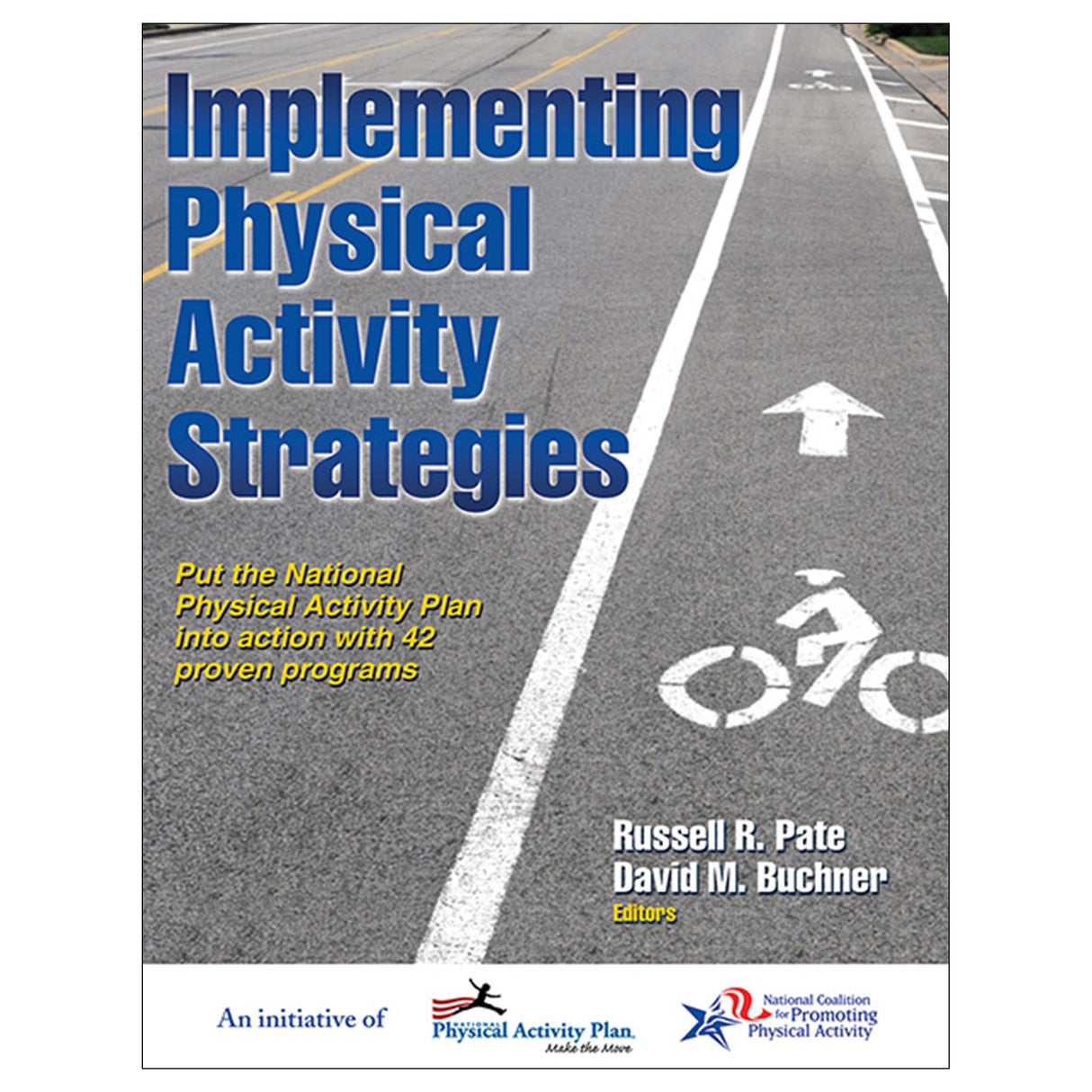Implementing Physical Activity Strategies PDF
Author: Russell R. Pate, David Buchner
$68.95 CAD
Access Duration: 10 Years
Developed through a partnership with the National Physical Activity Plan Alliance and the National Coalition for Promoting Physical Activity (NCPPA), Implementing Physical Activity Strategies profiles 42 physical activity programs that are helping people adopt more active and healthy lifestyles based on the U.S. National Physical Activity Plan (NPAP). This resource combines the expertise of editors Russell Pate and David Buchner as well as a host of respected researchers and practitioners well known for their long-term advocacy for a more physically active society.
Implementing Physical Activity Strategies highlights innovative and proven physical activity programs under way in eight sectors: education; mass media; health care; parks, recreation, fitness, and sports; business and industry; public health; transportation, land use, and community design; and volunteer and nonprofit organizations. For each, readers will find an explanation of how the physical activity program was executed, how it aligns with the NPAP, the target population of the program, cross-sector collaborations and their benefits, and assessments of program effectiveness.
A consistent presentation of information on each program makes this comprehensive reference easy to use. The text maintains a focus on topics such as cross-sector collaboration, tactics and troubleshooting tips, and how each program aligns with the NPAP. This ensures readers will find tools and information to bring success to their own initiatives. Many of the program profiles include sample press releases, ads, screen shots, photos, surveys, follow-up forms, and other hands-on materials to help readers more readily translate the ideas and materials of these programs into new physical activity initiatives. By sharing examples and case studies of proven programs, Implementing Physical Activity Strategies supports those seeking ways to bring the benefits of increased physical activity to their constituents:
• Officials and managers in public health and health care
• Volunteer and nonprofit organizations
• Recreation, fitness, and sport leaders
• Physical education teachers
• Worksite health promotion advocates
• Transportation, urban policy, and design workers
Implementing Physical Activity Strategies offers a detailed look into exemplary programs that have brought about an increase in regular physical activity for individuals where they live, work, and play. Stimulate new ideas, inspire creativity and innovation, and set in motion new results-oriented physical activity initiatives with Implementing Physical Activity Strategies.
Sector I: Education
Chapter 1. State Physical Activity Policies
Chapter 2. Public School Physical Activity Legislative Policy Initiatives: What We Have Learned
Chapter 3. Role of Recess and Physical Activity Breaks during the School Day
Chapter 4. Physical Activity in Early Childhood Centers: New York City as a Case Study
Chapter 5. After-School Programs and Physical Activity
Sector II: Mass Media
Chapter 6. VERB It’s What You Do! and VERB Scorecard: Bringing a National Campaign to Communities
Chapter 7. Start.Living.Healthy: Using Mass Media to Increase Physical Activity in Hawai’i
Chapter 8. ParticipAction: The National Voice of Physical Activity and Sport Participation in Canada
Chapter 9. Wheeling Walks: A Targeted Mass Media–Led Physical Activity Campaign
Chapter 10. Mass Media Campaigns to Promote Physical Activity: Australia and New Zealand as Case Studies
Chapter 11. Communication Strategies to Promote the 2008 Physical Activity Guidelines for Americans
Sector III: Health Care
Chapter 12. Institute of Lifestyle Medicine
Chapter 13. Exercise Vital Sign at Kaiser Permanente
Chapter 14. Profession MD—Lifestyle Program
Chapter 15. Development and Implementation of the Physical Activity Vital Sign
Chapter 16. Strides to Strength Exercise Program for Cancer Survivors
Sector IV: Parks, Recreation, Fitness, and Sports
Chapter 17. ParK Through 12 and Beyond: Converting Schoolyards Into Community Play Space in Crowded Cities
Chapter 18. Learning to be Healthy and Active in After-School Time: The Säjai Foundation’s Wise Kids Program
Chapter 19. Moovin’ and Groovin’ in the Bayou: Summer Camps Increase Youth Physical Activity Through Intentional Design
Chapter 20. Finding Common Ground: Play Space Modifications Can Increase Physical Activity for All Children
Chapter 21. Pioneering Physically Active Communities: YMCA of the USA’s Healthier Communities Initiatives
Chapter 22. Professional Sport Venues as Opportunities for Physical Activity Breaks: The San Diego Padres' FriarFit Instant Recess
Sector V: Business and Industry
Chapter 23. Fit to Drive: Integrated Injury Prevention, Health, and Wellness for Truck Drivers
Chapter 24. Instant Recess: Integrating Physical Activity Into the Workday at Kaiser Permanente South Bay Health Center
Chapter 25. ChooseWell LiveWell: An Employee Health Promotion Partnership between Saint Paul Public Schools and HealthPartners
Chapter 26. What’s Next? Keeping NextEra Energy’s Health & Well-Being Program Active for 20 Years
Chapter 27. Johnson & Johnson: Bringing Physical Activity, Fitness, and Movement to the Workplace
Chapter 28. Building Vitality at IBM: Physical Activity and Fitness as One Component of a Comprehensive Strategy for Employee Well-Being
Sector VI: Public Health
Chapter 29. State-Based Efforts for Physical Activity Planning: Experience From Texas and West Virginia
Chapter 30. Health Impact Assessments (HIA): A Means to Initiate and Maintain Cross-Sector Partnerships to Promote Physical Activity
Chapter 31. Move More Scholars Institute
Chapter 32. The National Society of Physical Activity Practitioners in Public Health:
Elevating the Issue of Physical Activity; Equipping Professionals to Do So
Chapter 33. Successful Cross-Sector Partnerships to Implement Physical Activity: Live Well Omaha Coalition
Chapter 34. Tracking and Measuring Physical Activity Policy
Chapter 35. Institutionalizing Safe Routes to School in Columbia, Missouri
Sector VII: Transportation, Land Use, and Community Design
Chapter 36. Local Public Health Leadership for Active Community Design: An Approach for Year-Round Physical Activity in Houghton, Michigan
Chapter 37. A Road Diet for Increased Physical Activity: Redesigning for Safer Walking, Bicycling, and Transit Use
Chapter 38. Incorporating Physical Activity and Health Outcomes in Regional Transportation Planning
Chapter 39. Leveraging Public and Private Relationships to Make Omaha Bicycle Friendly
Sector VIII: Volunteer and Nonprofit
Chapter 40. Using Legal and Policy Muscles to Support Physically Active Communities
Chapter 41. Reducing Barriers to Activity Among Special Populations: LiveStrong at the YMCA:
Chapter 42. New York State Healthy Eating and Physical Activity Alliance





